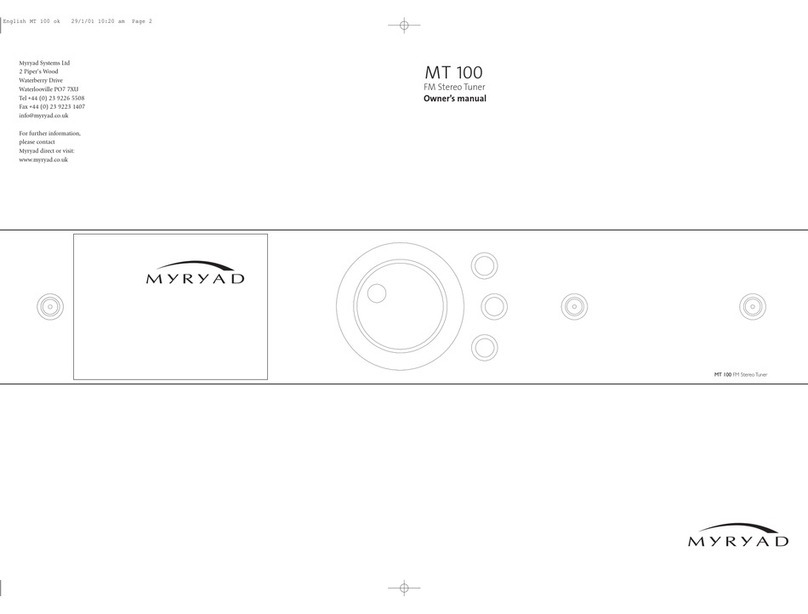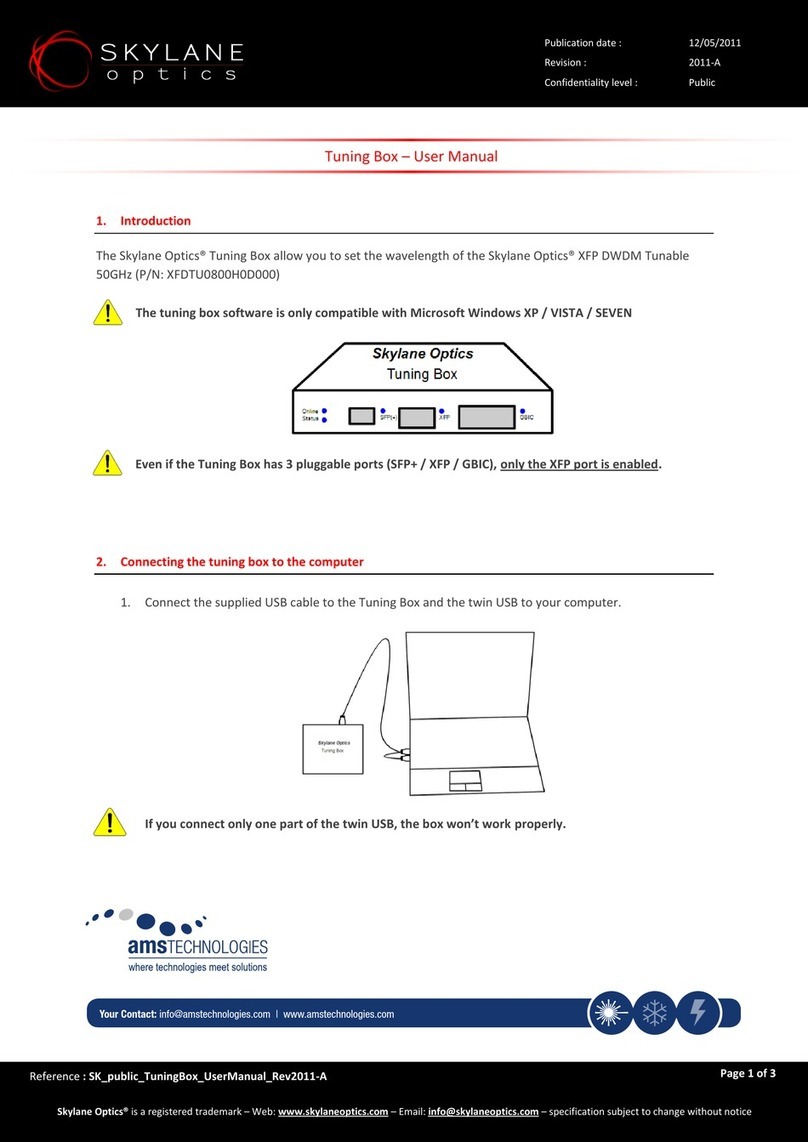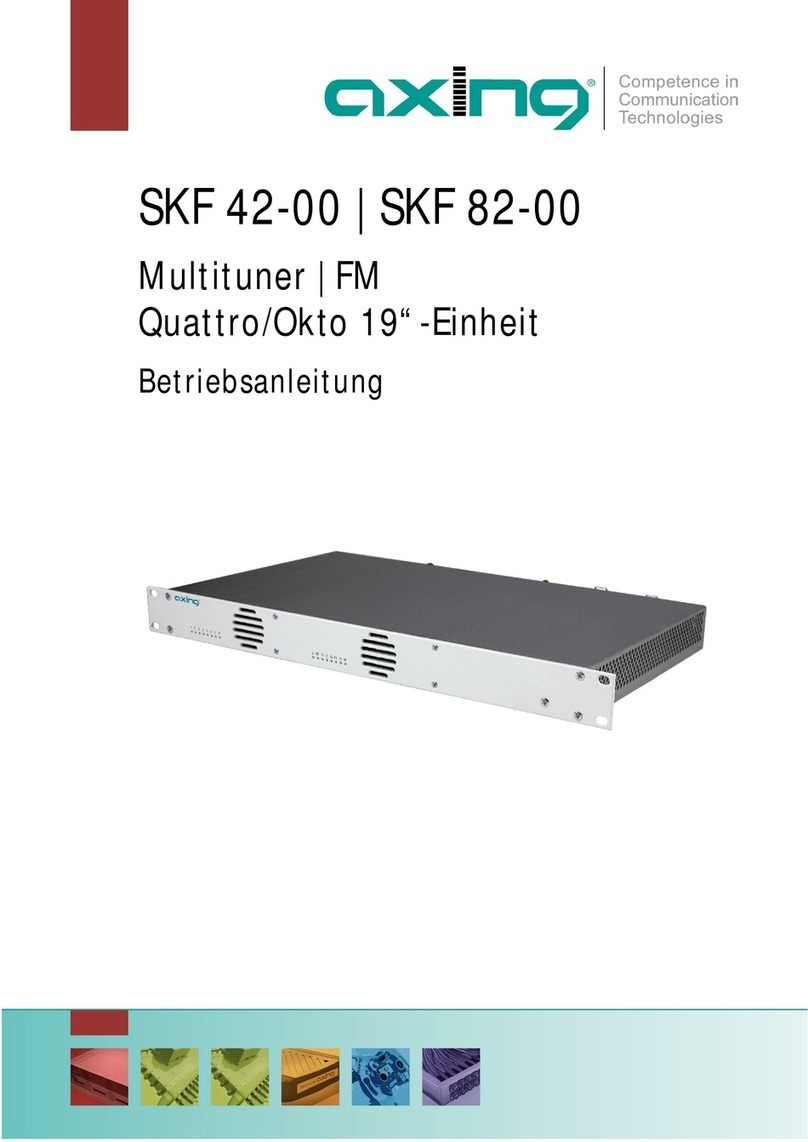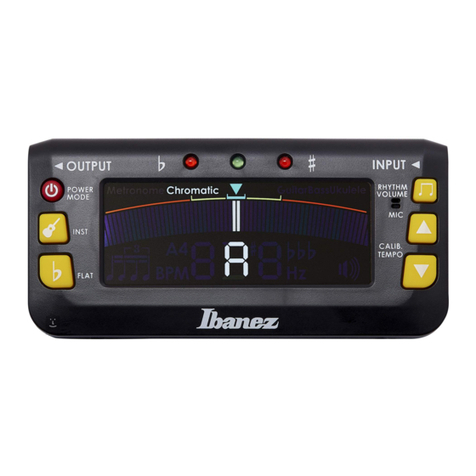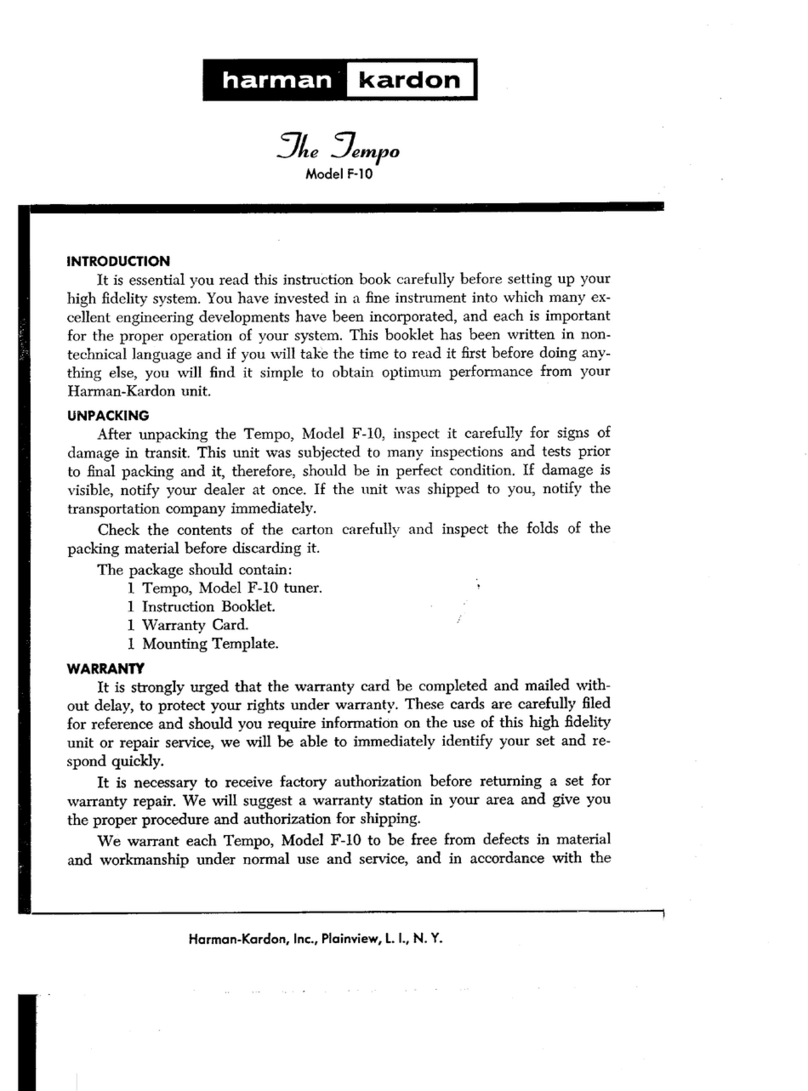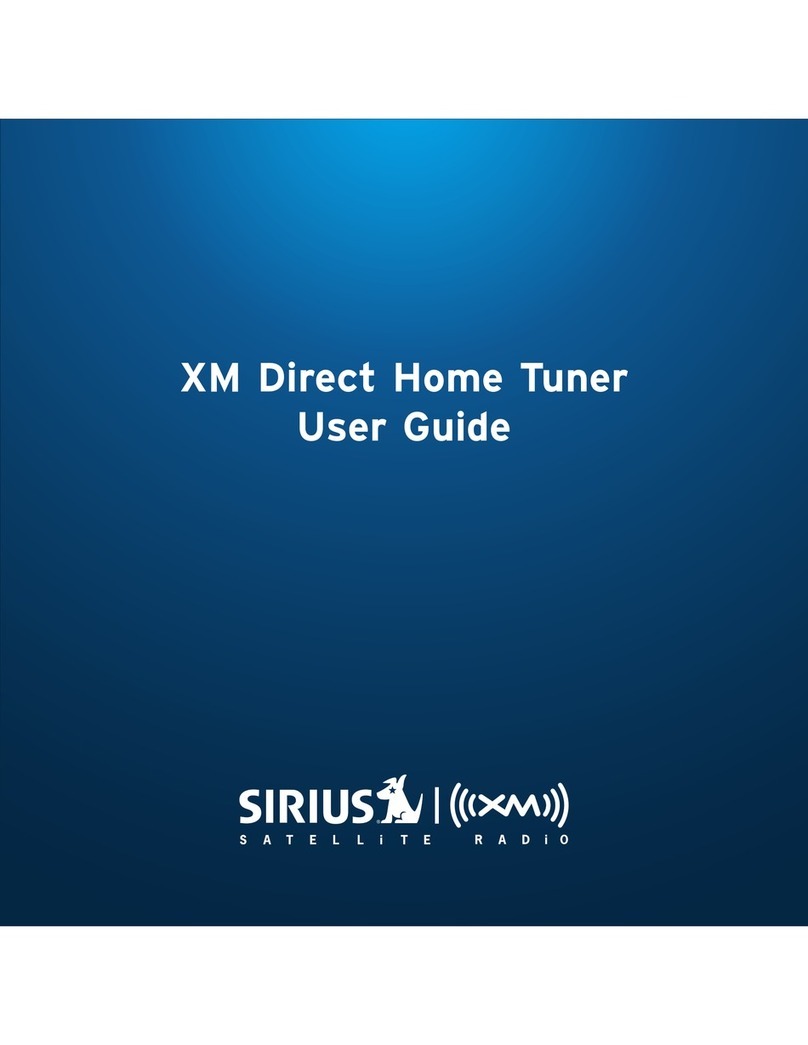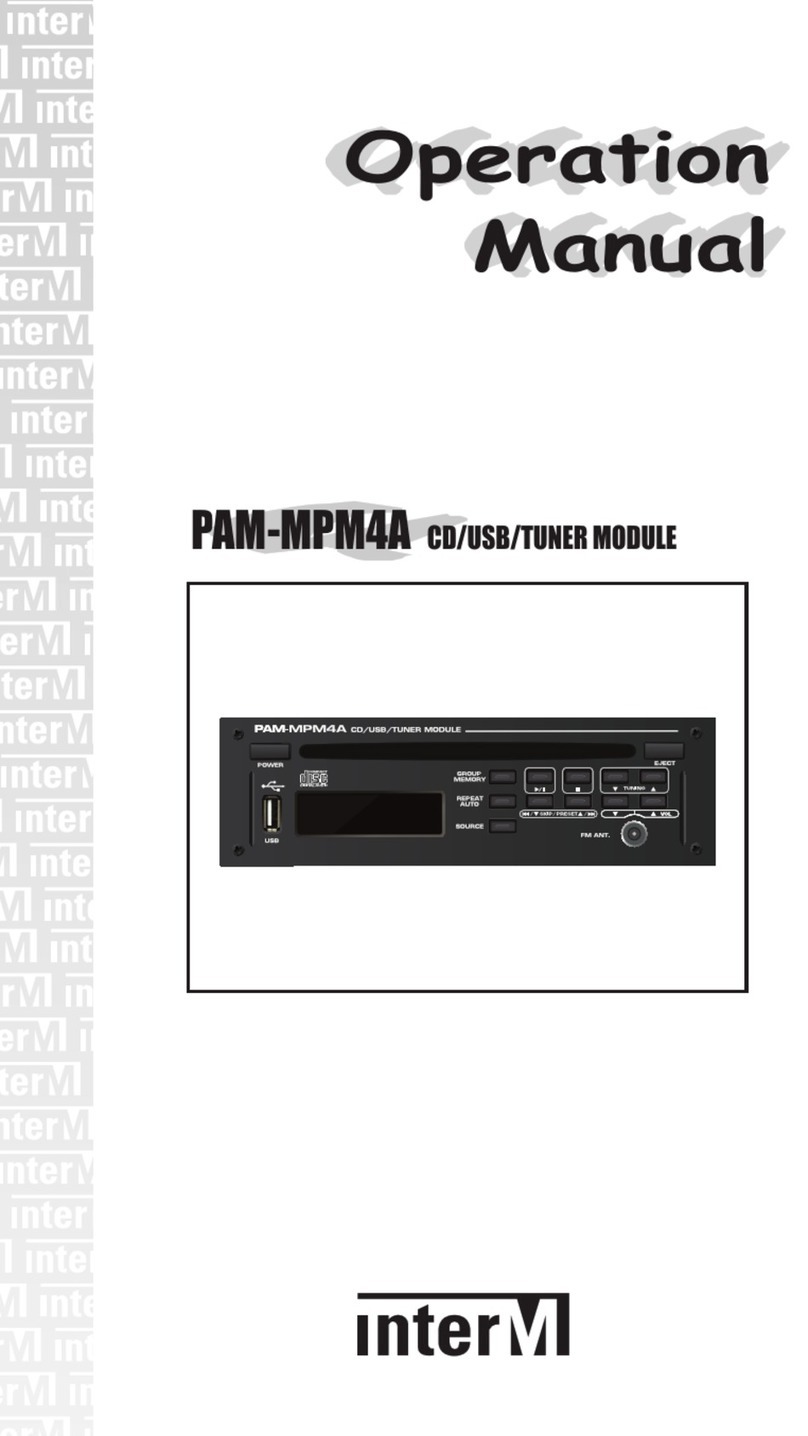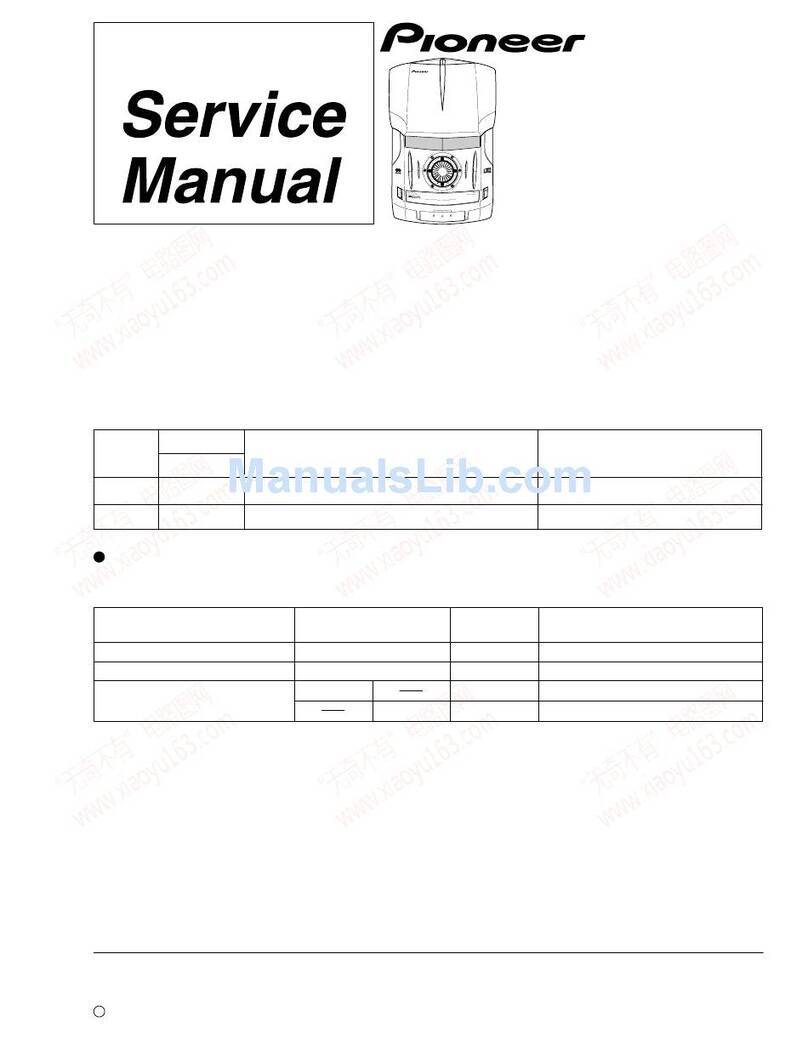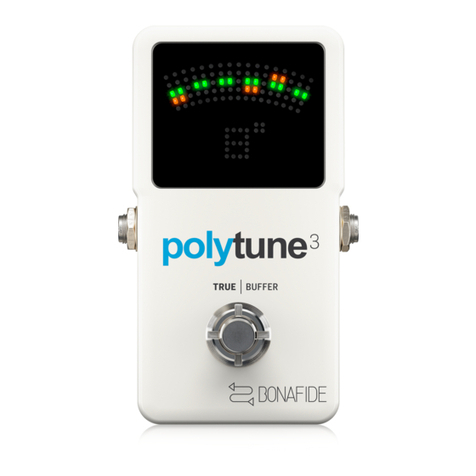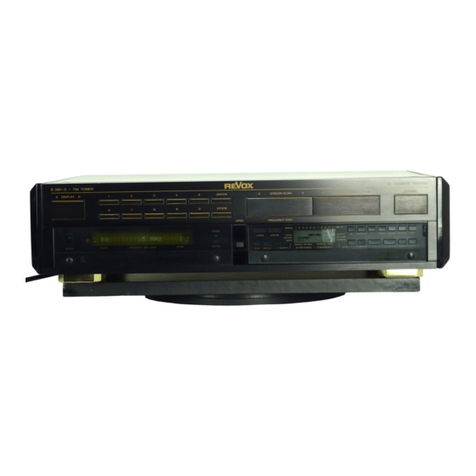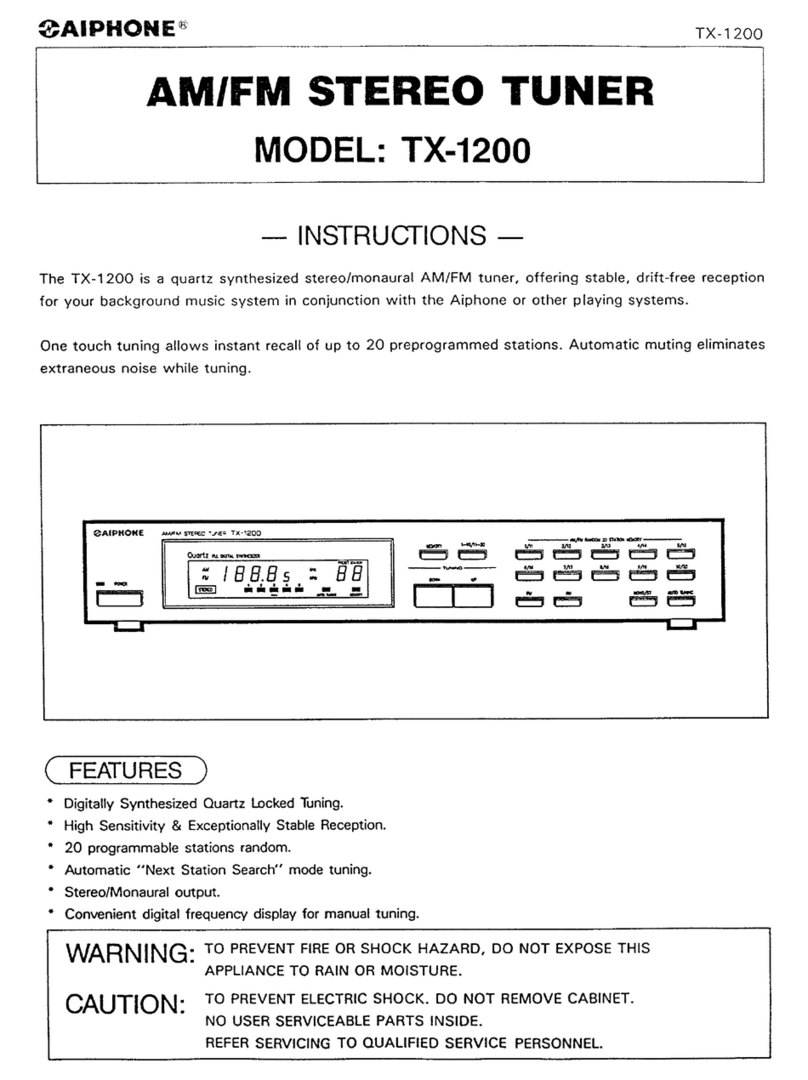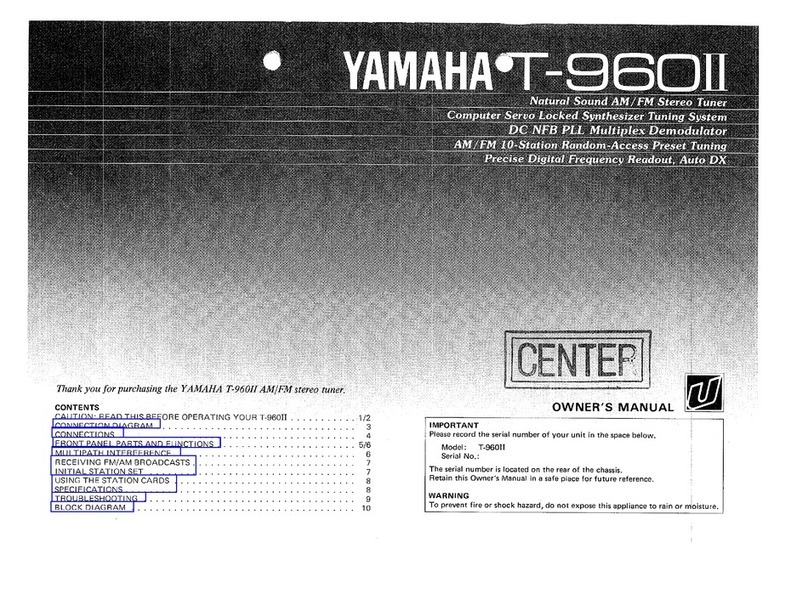Myryad Z130 User manual

Myryad Systems Ltd
2 Piper’s Wood
Waterberry Drive
Waterlooville PO7 7XU
Tel +44 ( ) 23 9226 55 8
Fax +44 ( ) 23 9223 14 7
For further information,
please contact
Myryad direct or visit:
www.myryad.co.uk
Z-SERIES
Z130 Remote Controlled FM RDS Tuner
Owner’s manual

2
contents
• Introduction 2
• Installation and Safety Notes 2
• Accessories 2
• Setting Up Your Tuner 3
Rear panel connections
• Operating Your Tuner 4
•Front panel controls
• System Remote Handset 6
• Installing and Replacing atteries 6
• Z-Series System Operation with 7
Smart My-Link
• Trouble-shooting guide 7
• Antennas 7
• Specifications 7
introduction
The Myryad Z13 has been designed to offer
a combination of high quality sound
reproduction and elegant styling.
It is a full-function remote-controlled FM
RDS Stereo Tuner. It has fixed-level low-
impedance audio outputs to feed a Myryad
integrated amplifier or preamplifier, or other
high quality amplifier. A coaxial antenna
socket is provided for a 75Ω FM radio (Band
2) antenna.
The Z13 also has a “Smart My-Link” control
input and output for communication with
other Myryad Z-Series, Cameo or M-Series
products.
When linked via the “Smart My-Link” to a
compatible Myryad integrated amplifier or
preamplifier a number of extra features
become available which make the system as a
whole easier and quicker to operate.
installation and
safety notes
This tuner generates very little heat but still
requires some ventilation. Do not place it on
a rug or other soft surface into which it could
sink, obstructing the air inlets in its
underside. Do not allow any obstruction to
the ventilation slots in the rear panel. The
tuner should not be installed in a built in
situation such as a bookcase or rack unless
proper ventilation is provided.
CAUTION:TO PREVENT A FIRE OR SHOCK
HAZARD, DO NOT PERMIT ANY OF THESE
PRODUCTS TO ECOME WET. IF LIQUID IS
ACCIDENTALLY SPILLED ON ONE, IMMEDIATELY
SHUT OFF ITS POWER AT THE WALL SOCKET
AND UNPLUG THE AC POWER CORD. ALLOW
SUFFICIENT TIME FOR COMPLETE
EVAPORATION TO OCCUR EFORE OPERATING
IT AGAIN. IF THE LIQUID IS ANYTHING UT
WATER AND/OR ALCOHOL, A QUALIFIED
SERVICE TECHNICIAN SHOULD EXAMINE THE
UNIT EFORE IT IS USED AGAIN.
DO NOT PLACE NAKED FLAMES SUCH AS
LIGHTED CANDLES ON THIS PRODUCT.
Do not remove the cover, or attempt to
modify or repair any item yourself.
Refer all servicing to a qualified technician.
accessories
Your Z13 is supplied with the following
accessories.
• Separate mains power cord to suit country
of sale.
• Remote control handset.
• Four AAA batteries for handset (not in
some countries).
• Wire antenna for high signal strength areas.
• Balun (matching adaptor) for connection
of 3 Ω antenna.
• Balun interface connector where necessary
(not all countries).
7
z-series system
operation with
smart my-link
When used as a linked system (e.g Integrated
Amplifier plus CD Player, DVD Player and
Tuner), Z-Series products have a number of
extra features that make the system as a whole
easier and quicker to use than a normal hi-fi.
These include:
Intelligent Input Selection (Amplifier):
Press a source select button on the remote
control and the system will awaken (if in
standby) only the Amplifier and the selected
source.
Power-Saving Mode (Amplifier):
The Amplifier will switch the CD Player, DVD
Player or Tuner into standby if any source
remains unused for more than ten minutes.
Automatic Switch-On (CD, DVD,Tuner):
If the standby button on the Tuner, CD or
DVD player is pressed, the Amplifier will also
awaken and select the correct source.
trouble-shooting
guide
Possible solutions to some of the most
common problems
No sound:
• Power turned off or system in standby
mode. Check that the green STANDBY LED
is illuminated.
• UK version only: The fuse in the mains
plug has failed. Check andreplace if
necessary.
Sound in one channel only:
• Interconnect cable pulled loose or making
poor contact. Check and,if necessary, un-
plug and re-plug all relevant cables.
Loud buzz or hum:
• Interconnect cable pulled partially out of
its socket.
• Defective interconnect cable.
Hiss that gets worse with STEREO reception:
• Antenna connector loose. Un-plug and
re-plug connector and check cable.
• Weak antenna signal. Move wire antenna
to optimize reception. If not adequate,
install a loft or external antenna.
• If all else fails, switch to MONO reception.
Stereo indicator fails to light during a
stereo broadcast:
• Another possible effect of a very weak
signal. Attend to the antenna system as
described above.
Distorted reception:
• “Multipath” reception. Rotate antenna to
find the orientation that provides the best
reception. Raise the height of the antenna.
If all else fails, switch to MONO reception.
For further help please visit:
www.myryad.co.uk/faqs.html
antennas
The wire antenna supplied with the tuner
may provide adequate reception of strong FM
signals. However, such an antenna is not very
efficient at rejecting “multipath” and other
forms of FM interference. Nor can it easily be
rotated to optimise its pickup pattern for best
reception of stations from different directions.
In most cases you will greatly improve
reception by using a better antenna.
The best choice is a directional FM-only
antenna, mounted as high above ground as
possible. The antenna should be mounted
externally for best reception, but loft
mounting is a simpler alternative which is
satisfactory in many locations when adequate
loft space is available. The type of antenna
necessary will depend upon both your
distance from the transmitter and the local
geography (e.g. intervening hills or large
buildings).
It is also most important to pay attention to
the quality of the coaxial cable used for the
downlead from the antenna to your tuner.
Avoid joins along the length of the cable and
ensure that the exposed end at the antenna is
properly weatherproofed against ingress of
moisture. All cables lose some signal along
their length and it is false economy to use
cheap cable of unknown quality. Always
specify the best “low loss” coaxial cable.
The above notes are for guidance only. It will
usually be best to consult a local specialist
aerial/antenna contractor who will have knowl-
edge of local reception conditions. Your
Myryad dealer may also be able to offer advice.
specifications
Z130 FM RDS Tuner
Usable sensitivity (IHF mono) ......................................................................................................................................1.5µV
Signal/noise ratio ......................................................................................................................8 dB (mono) 74dB (stereo)
THD (1kHz) .............................................................................................................................. .1% (mono) .2% (stereo)
Frequency response (2 Hz - 15kHz) ..........................................................................................................................± .5dB
Stereo separation (1kHz) ................................................................................................................................................45dB
Dimensions (w x h x d) ..............................................................................................................................436 x 78 x 3 m
Weight (net) ..................................................................................................................................................................4.7.3kg
Supply voltage (set by internal wiring) ............................................................................................................12 or 23 V
Finish …………………………………………Natural Silver fascia with Silver Grey casing/Satin Black fascia with Black Casing.
Stock No: OST 1213
Revision: A
Coaxial antenna
socket (DIN type)
Female-to-female
adaptor (DIN versions
only)
Coaxial antenna
socket (F type)
Antenna connectors and adaptors
3 Ω adaptor
(balun) (F type is
similar)
Wire antenna

Alarm on/off (ALARM ON/OFF)
Use this option to enable/disable the alarm.
When the alarm setting option (above) is
used, the alarm is automatically set to ON. To
disable (or enable) the alarm, select this
option and use the TUNE buttons to choose
off (or on) and then press SELECT. This
procedure allows the alarm to be turned on
or off without having to reset the alarm times.
Clock set (CLOCK SET)
Use this option to set the clock. The
procedure is exactly the same as for setting
the Alarm time – using the SELECT and
TUNE UP/DOWN buttons. If you tune to an
RDS station which broadcasts a time code,
the tuner will to set the time precisely using
the RDS data.
However please note that the RDS clock set
facility may not be available in all countries.
Memory Clear (MEMORY CLR)
Use this feature to clear unwanted preset
stations from the memory. Press SELECT to
choose memory clear then use the TUNE
buttons to cycle through the three available
options:
• CLEAR ONE – clears the currently
selected preset
• CLEAR ALL – clears all preset information
from the memory and leaves preset 1
tuned to 98.55MHz.
• FACTORY SET – returns the unit to the
default factory settings. This option
includes clearing all preset information
and leaves preset 1 tuned to 98.55MHz.
When the desired option has been selected,
press SELECT again to execute the chosen
Memory Clear operation.
9 Mono
When the MONO button is pressed the tuner
is locked into MONO reception mode and the
STEREO indicator will not illuminate, whether
the tuned station is transmitting in stereo or
mono. The green LED next to the MONO
button will illuminate to indicate this mode. If
noisy reception is experienced in stereo mode,
pressing the MONO button will usually result
in a dramatic improvement in sound quality.
When a station is stored as a preset (see
below) the MONO status is also stored, and
will therefore be recalled whenever that preset
is accessed.
10 Store
The STORE button is used when storing the
preset station frequencies. The procedure
is as follows:
• Tune to the desired station using either
MANUAL or SEARCH tuning mode, and
set to MONO if required.
• Press the STORE button to enter STORE
mode, which illuminates the green LED
next to the button. The display will
automatically change to Preset mode at the
last used preset number.
• If the station is to be stored at a different
preset number, press the TUNE UP or
TUNE DOWN button until the desired
preset number is reached, otherwise move
directly to the next step.
• Press the STORE button again to store the
frequency at the preset number displayed.
The tuner will then automatically return to
the previous tuning mode ready to tune the
next station and the STORE LED will be
extinguished.
STORE mode can be exited by pressing
the MODE button. The preset station data
is stored in a permanent memory. The
information is retained when the tuner
is switched off.
system remote
handset
operation
The Z13 Tuner is supplied with a System
Remote Handset. which can also be used to
control the Z14 Integrated Amplifier and
Z11 CD Player.
The System Handset keys allocated to control
of the tuner are as follows:
Preset, Manual and Search
These keys allow direct access to any of the
three tuning modes (see front panel MODE
button).
Tune up and tune down
These keys operate exactly as the front panel
TUNE UP/DOWN buttons.
Mono and store
These keys operate exactly as the front panel
MONO and STORE buttons.
DIM and number keys (0-9)
These keys control the tuner but only when
the handset is in “Tuner Mode”. To put the
handset into Tuner Mode simply press the
TUNER input select key at the top of the
handset. The handset will stay in Tuner Mode
until the CD input select key is pressed.
Keypad 0-9
These keys allow direct access to any preset
station. If a preset numbered 1 to 29 is
desired, (e.g. 14) press “1”, followed by “4”. If
“1” is pressed without a second digit, the
tuner will go to preset 1 after few seconds.
Pressing any other number key, from 3 to 9,
will tune instantly to the relevant preset
station.
The “ ” key may be used as the second digit
in the normal way to choose presets 1 , 2
and so on. However, when the “ ” key is
pressed as the first digit it operates in the
same way as the SELECT key on the front
panel (see Front Panel #8 on page 5).
DIM
The display may be switched off using the
DIM key. A second press will turn the display
on again. The display will come on briefly if
any control is used while the display is off.
Standby
Pressing the STANDBY key by itself sends the
command to switch an amplifier into or out
of STANDBY mode. However, if your Tuner is
linked to the amplifier via the Smart My-Link
then it will also be switched into or out of
STANDBY.
It is also possible to switch only the Tuner
into or out of by pressing and holding down
the TUNER key and then simultaneously
pressing the STANDBY key. This will switch
the STANDBY status of the Tuner without
affecting any other unit.
If Smart My-Link is being used the STANDBY
and TUNER keys must be released
simultaneously.
installing
and replacing
handset batteries
The System Remote Handset uses four 1.5 V
type AAA batteries. To fit new batteries first
open the battery compartment in the rear of
the handset and remove any existing batteries.
Fit the new ones as directed by the symbols
moulded inside the battery compartment,
then replace the battery compartment cover.
The batteries should always be removed if
they are discharged (indicated by no remote
control operation or by operation only at very
short range), or if the remote control is not
going to be used for an extended period.
6
3
setting up your
tuner
rear panel
connections
1Power inlet
Before making any connection, check that the
mains voltage setting printed on the rear
panel is the same as your local mains supply.
Plug the female (socket) end of one of the
power cords supplied into the power inlet on
the rear of each component. Plug the male
(plug) end of each cord into a “live” wall
socket or a suitable heavy duty extension
cable.
UK version: The mains plug is supplied fitted
with a 5A fuse. It should only be replaced
with a fuse of the same rating (5A) which
complies with BS1362.
2Power switch
Press one side of this rocker switch (the side
nearer the edge of the rear panel) to switch
the tuner ON and the other side to switch it
OFF. When the POWER switch is in the OFF
position all power is disconnected from the
tuner and it cannot be powered up from the
front panel or the remote control. When the
POWER switch is in the ON position (and
the power cord correctly inserted and plugged
in to a live wall socket) the tuner will power
up in standby mode (see FRONT PANEL
CONTROLS, STANDBY, below).
It is recommended that the POWER switch is
turned OFF if the tuner is not going to be
used for an extended period of time.
3My-Link input/output
When this tuner is used in a system with
other Z-Series (or Myryad M-Series or
Cameo) products, all may be joined together
via the My-Link. My-Link is a
communications bus that allows all the
linked components to operate together as a
system and distributes the remote commands
received by any one to each of the others. The
simplest function provided by the My-Link
bus is that all linked units will switch into or
out of standby mode when the amplifier or
remote control standby key is pressed.
Use a short RCA-to-RCA (phono-to-phono)
interconnect cable to connect from the MY-
LINK OUT socket on the amplifier to the
MY-LINK IN socket on the tuner.
A second cable may then be run from the
MY-LINK OUT socket on the tuner to the MY-
LINK IN socket on a Myryad CD player –
“daisy-chain” fashion. Further compatible
Myryad products can be linked in the same
way, running from the MY-LINK OUT socket
on the CD player. Inexpensive interconnects
may be used as the My-Link bus carries only
control signals, not audio, so these cables
have no effect on sound quality.
When Myryad products equipped with
“Smart My-Link” are connected via the My-
Link bus, many more powerful system
features are available (see page 7).
4 Antenna input
The tuner is fitted with a 75Ω “coaxial”
antenna socket, which must be used with a
75Ω antenna (aerial). The tuner is supplied
with a simple wire 3 Ω antenna together
with an impedance matching adaptor. This
antenna is provided to ensure that the tuner
can be set up and used straight “out of the
box”. It is not adequate to provide full
performance from the tuner except in areas of
particularly high signal strength (e.g. close to
the FM transmitter). In most instances a good
quality roof or loft mounted FM antenna
should be used – see page 7.
The tuner has different coaxial antenna
sockets to suit different countries. “North
American” models are fitted with “F” type
coaxial connectors while models for most
other countries are fitted with “DIN” style
connectors. When using the 3 Ω wire
antenna the matching adaptor (or balun)
must be used and “DIN” versions also need
to be fitted with the adaptor supplied. See the
illustrations on page 7 for clarification.
When you unfold the wire antenna you will
note that it is in the form of a “T”. The
“crossbar” portion of the T should be
stretched out horizontally and tacked in
place, either on a wall or the back of a
cabinet, or on the ceiling. The “vertical”
section of the T goes to the tuner’s antenna
input via the balun. Experiment with the
position and orientation of the antenna to
obtain the best reception.
5 Line outputs
These outputs should be connected by high
quality audio interconnects to the TUNER or
or other “Line” inputs (e.g. “AUX”) of any
integrated amplifier or pre-amplifier. Never
connect to an amplifier’s PHONO inputs.
45

4
267
45910
13
operating your
tuner
front panel
controls
1 Standby
When the tuner is plugged into a live wall
socket and the POWER switch is turned ON,
it will power up in “standby” mode and the
LED (Light Emitting Diode) by the STANDBY
button will glow red. In this mode the
internal circuitry is powered up, but disabled
so that it consumes very little power and the
audio outputs are muted by a relay.
When the STANDBY button is pressed the
circuitry is activated and, after a few seconds
delay, the audio outputs will be enabled.
During this delay period while the internal
circuitry is settling the STANDBY LED will
flash green. When the outputs are de-muted it
will glow green continuously. When the
STANDBY button is pressed again the
component will be returned to standby
mode, the STANDBY LED will glow red again
and all other LEDs and the display will be
extinguished.
CAUTION:WHEN IN STAND Y MODE THE
INTERNAL CIRCUITRY IS STILL LIVE, SO ALL
SAFETY PRECAUTIONS MUST E FOLLOWED.
2 Infra-red receiver
The infra-red (IR) remote control receiver is
mounted behind this window in the position
indicated. It must therefore not be obscured
when the component is to be operated using
the remote control handset. Where possible it
is best to arrange that the IR window is in
“line-of-sight” of the remote handset. When
components are connected via the Smart My-
Link bus, only one needs to receive the IR
command signals in order to control any of
the linked units.
3 Display
The operation of the tuner is indicated on a
high quality green Vacuum Fluorescent
Display.
4 Stereo indicator
This green LED is illuminated when a stereo
broadcast is being received and the tuner is
not switched to MONO mode.
5 On tune indicator
This green LED is illuminated when any FM
signal, above a very low threshold, is received
and is ON TUNE.
6 Tune up and tune down
These buttons are used to set the frequency in
MANUAL, PRESET and SEARCH modes. The
function of the buttons is determined by the
mode selected (see below), but in all modes,
pressing the right hand button will perform
an incremental operation and the left hand
button a decrement.
7 Mode
The MODE button is used to change between
PRESET, MANUAL and SEARCH tuning modes.
Preset tuning mode
When PRESET mode is selected the tuner will
go to the frequency of the last used preset
station and the display will show the tuned
frequency and the preset number (see Figure
1). When the TUNE UP button is pressed it
will tune to the preset stored with the next
higher number while pressing the TUNE
DOWN button will move to the next lower
stored preset. The tuner will skip preset
positions that have not been programmed,
e.g. if station 3 is not programmed, the tuner
will skip from station 2 to station 4. If the
tuner is stepped beyond the highest number
preset stored, it will “wrap-around” and step
back to the lowest numbered preset.
Preset display mode (Figure 1)
Manual tuning mode
When MANUAL mode is selected the display
shows the tuned frequency, together with a
Signal Strength indication (see Figure 2).
When the TUNE UP button is pressed briefly
the tuned frequency will increase by 5 kHz.
Holding the button down will cause the tuner
to scan continuously up the frequency band.
In a similar way, pressing TUNE DOWN will
decrease the tuned frequency or scan down
the band. Correct tuning can be obtained
either by setting the correct frequency, if it is
known, or by tuning until the ON TUNE
indicator illuminates – which indicates
accurate tuning. Once a station is tuned, its
frequency may be stored as one of the Presets
if desired (see page 6).
STEREO MODE SELECT MONO STORE
TUNE
STANDBY
5
Manual display mode (Figure 2)
The signal strength indicator will display a
number from 1 to 8, preceded by the letters
“SI”. A signal strength of “–” indicates no
signal, whilst a signal strength of 8 indicates a
very strong signal. Normally an indication of
4 or 5 is necessary for a useable signal in
stereo, while a figure of 6 or 7 should ensure
that lowest noise reception is obtained in
stereo. If the signal strength of a station tuned
in Preset mode is required, simply switch to
Manual mode after tuning. A Signal Strength
reading of 5 or below indicates that improved
sound quality might be achieved by improving
the antenna system.
Search tuning mode
When SEARCH mode is selected the display
shows the tuned frequency, together with SC
”n” where “n” is the signal strength (1 to 8).
When the TUNE UP button is pressed the
tuner will commence searching for FM
stations at frequencies higher than the start
point and the display will change to SCH
during search (see Figure 3). If the TUNE
DOWN button is pressed the tuner will
search lower frequencies. When the first
station of adequate strength is detected, the
tuner will stop searching, the display will
return to SC ”n” to show the signal strength
and the ON TUNE indicator will illuminate.
Once the station is tuned, its frequency may
be stored as one of the Presets if desired (see
page 6), or the search initiated again by
pressing the desired TUNE button. Searching
may be stopped before a station is found by
pressing the TUNE button in the opposite
direction to the current search, or by pressing
the MODE button.
Search display mode (Figure 3)
8 Select
The basic tuner functions (tuning and mode
controls for example) are all directly
available, both from the front panel buttons
and the remote handset. In order to access all
features however, it is necessary to use the
menu system.
To enter the menu system, press the SELECT
button on the front panel or the “ ” key on
the remote handset. The display will change
to show “CONTROL MENU”. Use the TUNE-
UP and TUNE-DOWN buttons to cycle
through the list of features before pressing
SELECT (or “ ”) again to make your choice.
You may exit the menu system at any time
without selecting an option by using one of
the following methods:
• press ‘9’ on the remote handset key pad,
• press Select while the display shows,
“CONTROL MENU”
• wait for the menu to time-out after about
15 seconds.
In all of these cases, the display will revert to
the previous mode operation.
NOTE:THE MENU CANNOT E ACCESSED
WHILE THE TUNER IS IN STAND Y OR DURING
THE 5SECOND START-UP PERIOD WHEN
SWITCHING THE UNIT OUT OF STAND Y.
The features available via the menu system are:
Station name (Display will show: STN NAME)
Use this feature to display the name of the
station currently tuned. Press SELECT on this
option and then use the TUNE buttons to
choose Station Name on or off. Then press
SELECT again to activate/deactivate the
Station Name feature. This feature can be
switched off by selecting Control Menu-Stn
Name-Off or by turning on another feature
(i.e. programme type, programme type search
or traffic search).
Programme type (PRG TYPE)
Use this feature to display the programme
type of the currently tuned station (e.g. News,
Pop/Rock, Drama etc.). Press SELECT on this
option and then use the TUNE buttons to
select on or off. Then press SELECT again to
activate/deactivate the Programme Type
feature. This feature can be switched of by
selecting Control Menu-Prg Type-Off or by
turning on another feature (i.e. station name,
programme type search or traffic search).
NOTE:“STATION NAME” AND “PROGRAMME
TYPE” ARE NOT DISPLAYED WHILE THE TUNER
IS IN SEARCH MODE OR WHILE A PRESET IS
EING PROGRAMMED.
Programme Type Search (PRG TYPE SCH)
Use this feature to search for a station
broadcasting the chosen type of programme.
Press SELECT on this option and then use the
TUNE buttons to select the desired
programme type (e.g. News, Pop/Rock,
Drama etc.). Then press SELECT again and
the tuner will mute and search until it finds
the desired programme type or until the
search is cancelled by the user. Cancel the
search by pressing the SELECT or MODE
buttons on the front panel or by pressing and
holding briefly the “ ” or a tuning mode key
on the remote control. When a station
broadcasting the desired programme type is
found, the tuner will stop searching, de-mute
and change to manual tuning mode. The
display will then show the programme type.
Traffic Search (TRAFFIC SCH)
Use this feature to search for a station broad-
casting a traffic announcement. Press SELECT
on this option and the tuner will mute and
search until it finds a traffic announcement or
until the search is cancelled by the user.
Cancel the search by pressing the SELECT or
MODE buttons on the front panel or by
pressing and holding briefly the “ ” or a
tuning mode key on the remote control.
When a traffic announcement is found, the
tuner will stop searching, de-mute and change
to manual tuning mode. The display will then
show “TRAFFIC”. When the traffic
announcement is finished, the unit will
resume its search.
Display time (DISPLAY TIME)
Use this option to display the current time.
The time will be displayed for a short period
before the display reverts to its previous
mode.
Alarm set (ALARM SET)
Use this feature to set the on and off times of
the alarm. Press SELECT to choose this
option then use the TUNE-UP and TUNE-
DOWN keys to set the minutes part of the
alarm on time (display will show “MN ON
XX.YY” where XX is the hours and YY is the
minutes). Press SELECT to confirm that the
minutes are correct then use the TUNE
buttons again to set the hours (display will
show “HR ON XX.YY”). Then press SELECT to
confirm the hours. The alarm off time may
then be set using the same procedure. When
the Alarm off time has been set, use the
TUNE buttons to choose between using the
tuner or CD player as the source when the
alarm is activated. If you choose tuner, it will
switch to the last tuned frequency when the
alarm-on time is reached. If you choose CD
player, ensure that a disc is in the CD player
as this will be played when the alarm-on time
is reached.
Once set, for example as a wake-up alarm, the
system should be switched into standby.
When the alarm-on time is reached, the
amplifier and the tuner/CD player will be
switched out of standby and the chosen
programme will be heard. Please ensure that
the amplifier volume is appropriately set.
When the alarm off time is reached, the
amplifier and tuner/CD player will be
switched back into standby.
Other Myryad Tuner manuals
